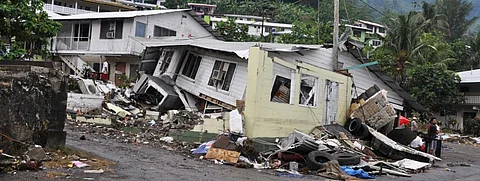

A new way to improve the prediction of earthquakes has been developed by researchers, according to a study published in the Journal of Geophysical Research: Solid Earth July 13, 2020.
Earthquakes are difficult to predict, making it challenging to save lives. Two of the worst natural disasters in the past 30 years were earthquakes. The first was the 2004 earthquake and tsunami that killed 220,000 people and the second was the Haiti earthquake in 2010 in which 159,000 people lost their lives.
Earthquakes killed over 923,000 people worldwide between 1990 and 2019, according to the United States Geological Survey (USGS).
A new equation — developed by researchers of the Heriot-Watt University in Edinburgh, the University of Liverpool and Utrecht University — has brought back the focus on earthquake prediction.
Earthquakes usually occur along faults that are fractures between rocks and can range from a few millimetres to thousands of kilometres.
During an earthquake, seismic waves are generated in a short span of time after two blocks of earth slip past one another. The waves travel to the surface causing destruction.
The surface where they slip is known as the fault or fault plane.
Scientists have attempted to recreate these faults in their laboratories to try and understand the conditions in them during earthquakes.
The actual conditions, however, are so complex that it is difficult to recreate them with accuracy, making earthquake prediction difficult.
Sabine den Hartog at the Lyell Centre, a strategic partnership between Heriot-Watt University and the British Geological Survey, along with her colleagues at the University of Liverpool and Utrecht University, used a different approach for earthquake prediction.
They tried to predict the frictional strength — the force required to cause movement along a fault — of phyllosilicates: Minerals in the form of thin plates found along the weakest part of the faults where earthquakes occur.
“We’ve created a model to predict the frictional strength of phyllosilicates under conditions that cannot be attained in a laboratory,” said Hartog.
The researchers analysed artificial fault zones on a microscopic scale to identify processes that occurred during the experiment.
A set of equations were then formulated to predict how the frictional strength of phyllosilicate changes, along with a change in conditions such as humidity or the rate of fault movement.
This made it easier for modellers to simulate fault movement in natural conditions, including earthquakes.
“Our model predicts that movement along phyllosilicate-rich fault zones becomes more difficult as it becomes faster, something that is consistent with experiments,” said Hartog.
This behaviour prevents earthquakes and suggests minerals other than phyllosilicates are important in causing earthquakes, according to Hartog.
More work is needed, said Hartog, citing the relation between the force that holds a fault together and the force needed to move the fault.